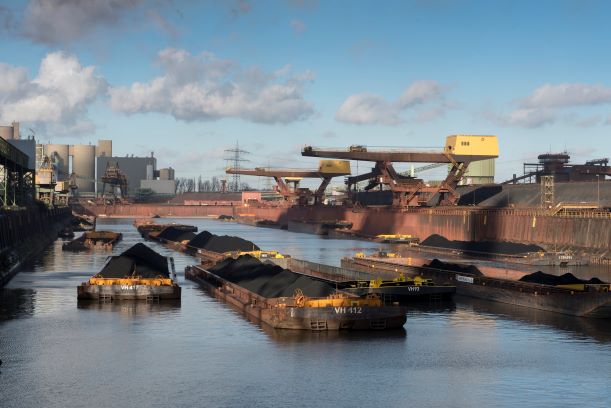tk Steel testing app for tracking push barges
by Hans Diederichs

It is around 240 kilometers by ship down the Rhine from Europoort Rotterdam to the iron and steel mill of thyssenkrupp Steel (tk Steel) in Duisburg. The river plays an important part in the supply of raw materials to the mill and the direct route is a key locational advantage: up to 10,000 push barges supply the mill’s ports with iron ore, coal and other raw materials every year. Each of these over 75 meter long floating containers is capable of transporting up to 2,700 tons of raw materials. It’s a volume of traffic that needs to be well coordinated, because space at the thyssenkrupp ports of Walsum and Schwelgern is finite: only a limited number of barges can be parked or unloaded at the same time. As part of its digital logistics strategy, thyssenkrupp Steel is optimizing barge coordination with state-of-the-art sensor technology.
The key to success: information exchange
Logistics can sometimes only be planned with short lead times. Storms or poor visibility due to fog can cause delays, as can low Rhine water levels. Maintenance work on the blast furnaces can also temporarily reduce demand for raw materials. The result: sudden changes in barge traffic.
“There are disruptive factors that we have to take into account,” says Christoph Pohl from the handling and storage logistics team and responsible for raw material handling at the mill’s ports. “They can all be mastered – but for that to happen we need to exchange the necessary information flexibly and quickly.”
This is a complex operation because of the numerous functions that need to be notified of changes: from port planning to the blast furnace, from barge skippers to crane operators at the ports, from Rotterdam to Duisburg. For everything to run smoothly a lot of communication is required.
“Our goal was to implement a smart digital solution giving everyone access to a live map of the supply chain,” explains Walter Scheider from handling and storage logistics at thyssenkrupp Steel. “The idea was to reduce coordination requirements and make it possible to better synchronize processes.”
Overview at all times
The most important tools for coordinating the more than 100 barges and various push boats along the Rhine and in the ports are large amounts of operating data, cameras and telephones. The logisticians wanted to simplify this. Together with IT, handling and storage logistics and raw materials coordination, they sought a solution that would give everyone involved an overview at all times. They came up with a system whereby every barge is now IoT-capable (“Internet of Things”) and equipped with a solar-powered GPS sensor. The GPS data are combined with information on orders and cargoes. The result is a digital map allowing all parties to keep track of every barge at all times – including information on tonnage, raw material cargo and port arrival time calculated with the aid of artificial intelligence. As a result, time and costs can be saved – for example, by sending a signal to ship’s masters on their way to Duisburg telling them to reduce their speed – and fuel consumption – when it’s clear they would have to wait outside the port anyway.
“Live tracking allows us to plan much better in advance,” explains Christoph Pohl. “At the same time, the data we collect can help us analyze and optimize processes. For example, we can track precisely where and when which barges face waiting times and then look for ways to reduce them.”
Digital innovation rapidly implemented
But how did they get from the idea to the finished app? By taking an innovative approach: in just three weeks an interdisciplinary team of experts developed a prototype which was then tested in a field trial with six push barges. In addition to technical feasibility, the usability of the app during operation was tested and further findings were gathered.
“The new working format gave us a base to try out the innovative idea of tracking the push barges in an experimental environment and achieve results quickly,” says Tim Rupp from the digital innovation team.
At the same time the team has created a company-specific cloud-based platform on which further tracking apps can be implemented in the future. The new app is currently entering a test phase with participants from all areas involved. An initial wide-scale rollout is planned for the coming fiscal year.
Further step on the road to digital logistics
In the long term, tracking is set to provide a basis for further optimization and automation. Possibilities include evaluations of optimum port occupancy levels, the integration of forecast water level data or the inclusion of external ships in order to reduce mooring fees. The tracking of barges is a further step on the road to digital logistics being pursued by thyssenkrupp Steel as part of its digitization strategy.
Source and photo: tk Steel

